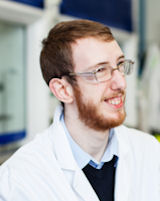You are here: Centre for Doctoral Training in Molecular-Scale Engineering > Our Students > William Seddon
William Seddon

Background
I studied for my undergraduate degree at the University of Leicester, where I graduated with a 1st Class MChem (Hons) Chemistry (Ind) degree. My industrial placement was with the Atomic Weapons Establishment (AWE), where I worked in the Analysis Team of the Tritium Technology Group.
Previous lab experience
The primary focus of my work at AWE was the assay of facility soft waste for residual activity levels to determine if it was below the Substance of Low Activity threshold. I also helped in the development of a prototype acid dissolution line for the assay of metal samples and performed an investigation into the effects of operating temperature on super-memory alloy retaining rings.
My Masters project was on the synthesis of novel spliceosome inhibitors through enantioselective organic catalysis. To do this I had to produce the MacMillan Organocatalyst and required reagents. This involved the handling of chiral and diastereoisomer compounds under dry conditions.
Why I chose to study in the CDT in Molecular-Scale Engineering
The CDT has received funding from the ESPRC based upon the requirement of Industry for people trained in nanoscale science and technology, and more importantly those with cross-disciplinary training and practical research. It is this cross-disciplinary nature which makes the CDT so attractive from both a research interest point of view, as well as the potential uses in the wider world, whether it is in further academic work or in the context of industry.
Whereas a conventional PhD trains you to be a specialist in a very specific area of science, the CDT give us a broader grounding in the field of nanotechnology as a whole. This gives us more flexibility and ultimately makes us more adaptable to the requirements of Industry.
The interdisciplinary nature of the course allows me access to other areas of interest outside of initial degree training, and introduces me to those which I had not previously considered. It also allows for a far broader scope for the potential projects, as they are not limited exclusively to their initial fields.
Current research
My first rotation is based on developing switchable adhesives by functionalising resorcinarene bowls with polyelectrolytic legs which can then be attached to surfaces. The adhesive bond can then be switched by altering the pH.
The second rotation will be focused on creating low-dimensional gold nanostructures to which light-harvesting photosynthetic proteins will be attached. The adsorption of these proteins will then be investigated by their optical coupling to the nanostructures. The third rotation will involve the preparation and characterisation of currently existing high-resolution optical microscopy dyes. Once the key structural motifs required for functionality have been identified, new dyes with controllable blinking will be designed and synthesised.
Most enjoyable aspect
By having the ‘cohorts’ of students and the initial residential week, I got to know a group of people who would be attending the same courses as me. This made the whole experience, especially starting at two new universities, far more enjoyable and has afforded me some good friends. The most challenging aspect is the coursework. The coursework for the taught components involves a lot of essays, which to someone with a background in science is a little bit of a shock. Balancing these with the work from the rotations can be challenging, but the benefits will be worth it in the end.
My future career
The course has given me a solid grounding in, and knowledge of, the wider field of nanotechnology and its applications as a whole. By working on problems or development in nanotechnology in the wider world I will be able to draw upon my experiences from the CDT and expand them to help resolve or advance these issues.
Activities I participate in outside of the CDT
My hobbies include digital painting and miniature painting. I am also a keen re-enactor and a member of the Crusade re-enactment society, which portrays the people, places, and professions of the cultures present in the Mediterranean during the crusading era. I am currently in the process of starting a Sheffield based group in association with the wider society.


